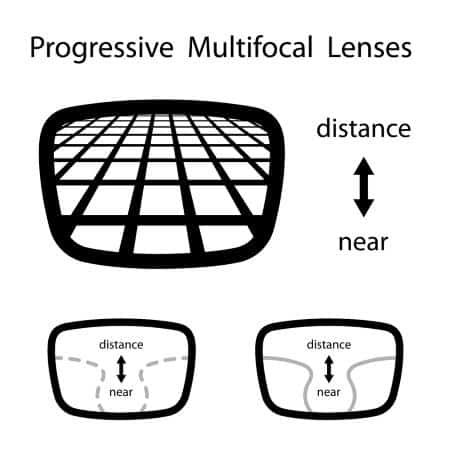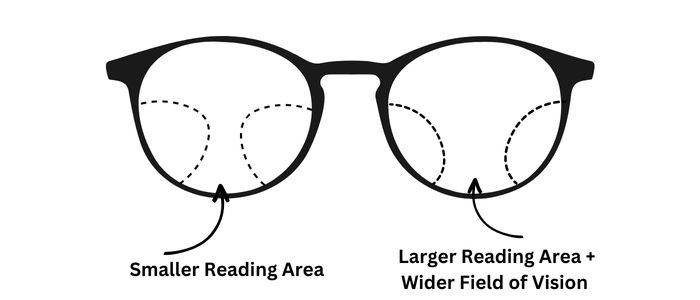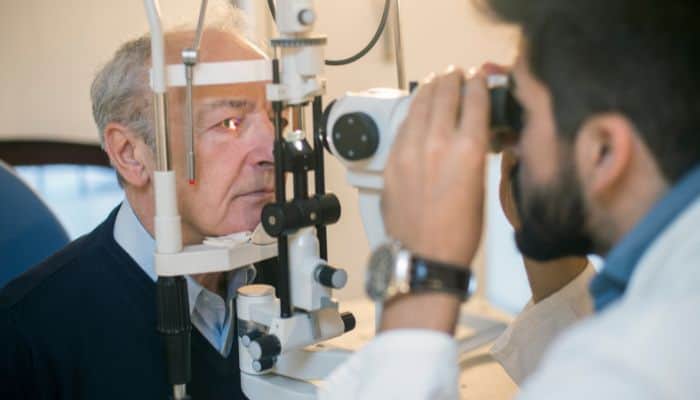(This page contains affiliate links. OGR may receive compensation if you click a link and make a purchase.)
Progressive eyeglass lenses, also known as no-line bifocals (or trifocals), are a type of multifocal lens with a seamless progression of corrective power for various viewing distances.
Unlike traditional bifocal lenses which feature two separate lenses with distinctly visible lines, progressive lenses have no such lines and appear to be a single continuous lens when worn.
The upper portion of the lens is used for distance vision, while the lower part is used for near vision and reading. The power gradually changes from top to bottom, allowing you to easily switch between different distances without having to constantly take off and put on your glasses.

Who Should Wear Progressives?
Progressive lenses are usually recommended for those who need both far- and near-distance vision correction.
In particular, they are beneficial for those with presbyopia, an age-related condition where the eyes slowly lose their ability to focus on objects up close.
This typically occurs around age 40 and is caused by the eye’s lens hardening over time.
While most people who experience presbyopia start off wearing over-the-counter reading glasses, over time you might find it annoying to constantly take them off or switch between glasses when looking at nearby objects and those in the distance.

This is where progressive lenses come in, as they provide a convenient and more natural way to see clearly at various distances with one single pair of glasses – without the jarring, unappealing lines found in traditional bifocals or trifocals.
Moreover, progressive lenses can also help those who have astigmatism or an uneven prescription in both eyes, since they are much more customizable than lined multifocal lenses.
Bifocals vs. Trifocals vs. Progressives
Advantages of Progressive Lenses
Seamless Design
The most obvious advantage of wearing progressives is their aesthetic appeal; without those conspicuous lines, your glasses don’t make it obvious that you’ve reached a certain age.
Gradual Focus Shift

As your gaze moves from one distance point to another, progressive lenses enable the eyes to gradually shift focus between different lens powers instead of making a sudden change.
This makes for a more natural visual experience while you switch from one viewing zone to another.
Eliminates Image Jumps
Besides better aesthetics, the gradual transition of powers also eliminates the annoying “image jump” associated with traditional bifocals or trifocals, where an object appears to move or change position when switching between different power corrections.
This image jump phenomenon with lined multifocals can be hazardous when walking up or down steps or curbs, as it can lead to a false sense of depth perception.
More Customizable

As an advanced lens design, progressive lenses can also be more accurately customized to fit your specific visual needs compared to lined multifocals.
Depending on the type of activities you do most often, your optometrist may recommend a certain type of lens or design that will work best for you.
For example, if you work at a computer daily and use the intermediate viewing area frequently, you might prefer a larger intermediate power segment than standard progressive lenses normally have.
Can Be Made Into Sunglasses
That’s right, besides regular optical glasses, you can also have sunglasses made with progressive lenses!

For instance, if you normally wear sunglasses while driving, a pair of progressive sunglasses works great for seeing both the road and your dashboard clearly.
Plus, progressive sun lenses are also available in various tints and shades, letting you customize the lens color based on your individual preference.
They can even be made with polarized or photochromic (or light-adjusting) lenses.
Get Progressive Sunglasses (With Free In-Home Try On)
Drawbacks of Progressive Lenses
Adjustment Period
The biggest downside to progressive lenses is that they can take some time to get used to.
It typically takes at least two weeks of consistent use for your eyes and brain to coordinate the different powers of the lens, so you may experience some blurriness or dizziness as you adjust.
Visual Distortions
Visual distortions are another common issue with progressives, causing objects to appear warped or blurry in your peripheral vision, particularly in the lower right and left regions.

This is true of all progressive lenses due to the physics of creating the lens, though the problem can be minimized by opting for a better, more advanced design.
Higher Cost
There’s no getting around this one: because progressive lenses are more complex and intricate to manufacture than lined multifocals, they are more expensive.
This is especially true if you choose a high-quality lens, which will help reduce the fishbowl effect (peripheral distortion) discussed above.
Limited Frame Shape and Size
Finally, not all eyeglass frames are suitable for progressive lenses due to their size and shape.
You need enough surface area to accommodate the multiple power corrections within the lens.
Frames with short lenses (anything less than 28mm high) don’t work well.
Certain shapes are also not ideal, such as aviators and cat eye frames, as these lack the necessary surface area near the bottom for comfortable reading and near-vision tasks.
How Can I Get Progressive Glasses?

You’ll need an eye exam with an optometrist or ophthalmologist to determine if progressive lenses are right for you.
After your exam, your doctor should provide a glasses prescription for progressive lenses that can be used to purchase your new glasses either online or in-store.
Be sure to ask questions and take advantage of any additional resources the optometrist has to offer when selecting the best lenses and frames for your needs.
Progressive lenses can be made from any of the usual optical lenses, including plastic, polycarbonate, high-index, and Trivex.
Your optometrist will also discuss any coatings that should be applied to your lenses for additional protection against scratches or glare.
Finally, you’ll want to ask about the warranty offered on your new progressive eyeglasses so that you can be sure you’re getting the best possible protection for your investment.